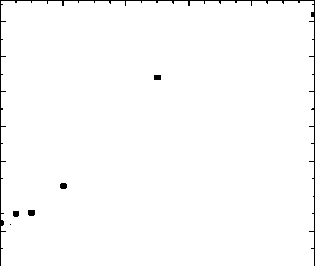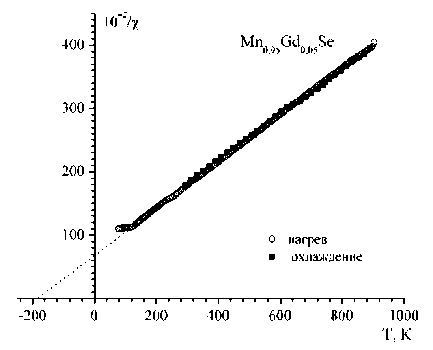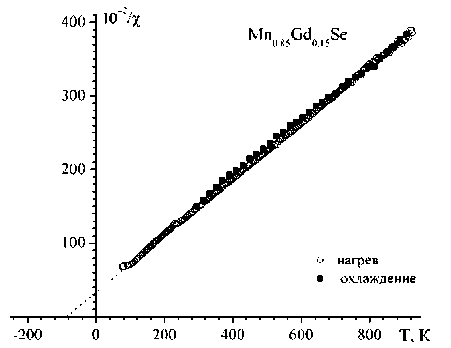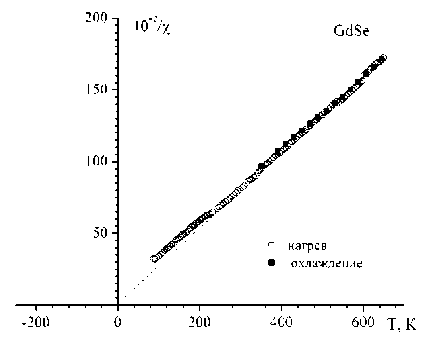Magnetic properties of Mn1-xGdxSe sol-id solutions
Автор: A. M. Zhivulko, K. I. Yanushkevich, E. G. Danilenko, F. V. Zelenov, O. N. Bandurina
Журнал: Siberian Aerospace Journal @vestnik-sibsau-en
Рубрика: Technological processes and material science
Статья в выпуске: 4 vol.23, 2022 года.
Бесплатный доступ
Potential materials for spintronics operating under extreme conditions based on manganese selenides substituted with gadolinium are investigated. The technology of synthesis of solid solutions based on solid-phase reactions using MnSe and GdSe compounds is presented. As a result, Mn1-xGdxSe solid solutions with concentrations x = 0.05; 0.1; 0.15 and 0.5 were synthesized. The synthesis was carried out under vac-uum conditions of 10–2 Pa. The products of the primary synthesis were subjected to thorough grinding into powders, from which tablets were made under pressure for homogenizing annealing at 1370 K. After two hours of exposure, the synthesis products were tempered in cold water. At the final stage, homogeneous strong ingots of greyish-silver color were obtained. X-ray phase analysis of synthesized solid solutions of the Mn1-xGdxSe system was performed in Cu-K radiation in the point-by-point measurement mode with a scanning step along the angle Δ2θ = 0,03 degree; the time of information collection at the reference point Δτ =3 seconds. The spatial symmetry group and the parameter of the elementary crystal cell of solid solu-tions of the Mn1–xGdxSe system from X-ray diffraction analysis are determined. The dependence of the pa-rameter value of the crystal lattice of solid solutions on the concentration of gadolinium ions is found. The specific magnetization was measured by the ponderomotor method in a magnetic field with an induction of B = 0.86 Tesla and the magnetic susceptibility of the samples was determined in the temperature range of 80 ≤ T ≤ 950 K. The cycles carried out in the heating - cooling mode did not detect a change in properties. The Neel temperatures and the paramagnetic Curie temperature are determined from the Curie – Weiss law depending on the concentration of a rare earth element. A decrease in the temperature of the magnetic phase transition is established.
Spintronics, magnetic susceptibility, ponderomotive method, Neel temperature, Curie – Weiss law
Короткий адрес: https://sciup.org/148329666
IDR: 148329666 | УДК: 537.312:538.911'956 | DOI: 10.31772/2712-8970-2022-23-4-748-755
Текст научной статьи Magnetic properties of Mn1-xGdxSe sol-id solutions
In the space industry, microelectronics must operate under extreme conditions. Small spacecraft are in Earth orbit, where the temperature varies from 180 to 400 K and the electronics must operate at these temperatures, thus, there is increased interest in magnetic semiconductors capable of operating in a wide temperature range. In magnetic semiconductors, the transport properties depend on the magnetic structure [1–6]. The correlation between magnetization and conductivity has been studied in detail theoretically and experimentally in manganites [7–11]. Magnetic characteristics depend on the elastic system, and for some critical parameters a magnetic structure changes dramatically [12–16]. The long-range magnetic order depends on the dimension of the system [17–20]. In the manganese sulfides substituted with 3d elements, the magnetic structure changes [21–23].
In this regard, synthesis is of interest, the study of magnetic properties depending on the chemical composition, temperature, magnetic field of solid solutions with cationic substitution in the Mn 1– x Gd x Se system. Manganese monoselenide is an antiferromagnet and a semiconductor р -type [24]. It was assumed that the replacement of manganese cations by the Gd ferromagnetic metal in solid solutions can create conditions for the manifestation of ferromagnetic properties. While maintaining the semiconductor properties of the main MnSe matrix, an possibility is created for the transition from an antiferromagnetic р -type semiconductor to a ferromagnetic semiconductor with n -type conductivity. The purpose of this work is the synthesis of solid solutions in the MnSe – GdSe quasi-binary section, the study of the features of their crystal structure, as well as the magnetic characteristics of solid solutions depending on the composition and temperature.
Synthesis of Mn1–xGdx Se Solid Solutions and Experimental Methods
The samples of the Mn1–xGdxSe solid solutions were synthesized by the method of solid-phase reactions. The manganese and gadolinium monoselenides were synthesized from powders of the initial chemical elements: electrolytic manganese metal (99.6%); gadolinium (–40mesh, 99% metals basis) Aldrich chemistry; elemental selenium (high purity grade 17–4). Based on the basic compounds of MnSe and GdSe, the Mn1-xGdxSe solid solutions with compositions x = 0.05; 0.1; 0.15 and 0.5 were synthesised. The synthesis was done under vacuum conditions 10–2 Pa. The products of primary synthesis were subjected to thorough grinding into powders. Tablets were formed under pressure for homogenizing annealing at 1370 K. After holding for two hours, the synthesis products were quenched in cold water. At the final stage, homogeneous strong ingots of a greyish-silver color were obtained. X-ray phase analysis of the synthesized solid solutions of the Mn1–xGdxSe system was performed in Cu-Kα-radiation in point-to-point measurement mode: scanning step along the angle Δ2θ = 0,03 degree, acquisition time at the reference point Δτ = 3 s. The temperature dependences of the specific magnetic susceptibility were studied by the ponderomotive method in a magnetic field with an induction B = 0.86 Tesla and a temperature range of ~80 ≤ T ≤ 950 K [25–26]. The error in measuring the magnetic susceptibility of a sample of known mass is Δχ ±1•10–11 m3•kg–1. The measurement error of the specific magnetization related to the mass of the measured sample is Δσ ± 0.005 A•m2•kg–1.
The results of the experiment
The MnSe and GdSe compounds and solid solutions Mn 0.95 Gd 0.05 Se, Mn 0.9 Gd 0.1 Se, Mn 0.85 Gd 0.15 Se have been synthesized. In the X-ray diffraction patterns of MnSe-based solid solutions, reflections are indicated based on the cubic cell of the space group Fm3m. Based on the results of X-ray studies, the values of the parameter a of the unit cell of the solid solutions of the Mn 1–x Gd x Se system were determined. The dependence a = f ( x ) is shown in fig. 1.
а, пт
0.575
0.570
0,565
0,560
0,555
0,550
0,545
0,540

0,575
0,570
0,565
0,560
0,555
0.550
0,545
0,540
0,0 0,2 0,4 0.6 0,8 1,0
Concentration, x
Рис. 1. Параметр а элементарной кристаллической ячейки твердых растворов системы Mn 1–x Gd x Se от концентрации
Fig. 1 a parameter of the elementary crystal cell of solid solutions of the Mn 1–x Gd x Se system from the concentration
The results of measuring the temperature dependence of the magnetic susceptibility 10–2/χ = f(T) of the solid solutions Mn 0.95 Gd 0.05 Se, Mn 0.9 Gd 0.1 Se, and the GdSe compound are shown in fig.2 - fig.5. With an increase in the content of gadolinium from x = 0.05 to x = 0.15, the Néel temperature of solid solutions decreases from the value Т N = 120 К for Mn 0.95 Gd 0.05 Se to Т N = ~100 К for Mn 0.85 Gd 0.15 Se. It should be noted that heating of solid solutions to a temperature of ~900 K does not lead to irreversible changes in the magnetic susceptibility, since the behavior of the dependences 10–2/χ = f ( T ) is identical for measurements in the “heating-cooling” mode. The revealed feature is of practical importance.
The magnetic susceptibility of solid solutions increases with an increase in the content of gadolinium in them. An increase in the content of gadolinium in solid solutions leads to a decrease in the Néel temperature from T N ~135 К for MnSe to T N ~90 К for Mn 0.85 Gd 0.15 Se.

Рис. 2. Обратная магнитная восприимчивость Mn 0.95 Gd 0.05 Se от температуры

Рис. 3. Обратная магнитная восприимчивость
Mn 0.9 Gd 0.1 Se от температуры
Fig. 2. Reverse magnetic susceptibility of Mn 0.95 Gd 0.05 Se from temperature
Fig. 3. Reverse magnetic susceptibility of
Mn 0.9 Gd 0.1 Se from temperature

Рис. 4. Обратная магнитная восприимчивость Mn 0.85 Gd 0.15 Se от температуры

Рис. 5. Обратная магнитная восприимчивость антиферромагнетика GdSe от температуры
Fig. 4. Reverse magnetic susceptibility of Mn 0.85 Gd 0.15 Se from temperature
Fig. 5. Reverse magnetic susceptibility of the GdSe antiferromagnet from temperature
The paramagnetic Curie – Weiss temperature also decreases with increasing concentration from θ eff ≈ |–200| K for x = 0 to θ eff ≈ |–90| K for x = 0.15 in Mn 0.1–х Gd х Se solid solutions. Using tgα of the angle of inclination to the temperature axis of the rectilinear part of the dependence 10–2/χ = f ( T ), the magnitude of the magnetic moment of solid solutions was determined. An increase in the content of gadolinium in solid solutions leads to an increase in the magnetic moment.
Conclusion
The solid solutions were synthesized in the Mn 1-x Gd x Se (0 ≤ х ≤ 0,5) system. Based on the dependence of the change in the parameter a of an elementary cubic crystal cell on the concentration a = f ( x ), we can assume, with some error, that continuous solid solutions in this system, under the synthesis mode being used, exist in the (0 ≤ х < 0,2) concentration range. The temperature dependences of the magnetic susceptibility of the solid solutions Mn 0.95 Gd 0.05 Se, Mn 0.9 Gd 0.1 Se, Mn 0.85 Gd 0.15 Se and the GdSe compound have been studied. It is establisehed that:
-
(a ) with an increase in the gadolinium content, the Néel temperature of solid solutions decreases from Т N = 135 К for Mn 0.95 Gd 0.05 Se to Т N = ~100 К for Mn 0.85 Gd 0.15 Se;
-
b) the magnetic susceptibility of solid solutions increases with an increase in the content of gadolinium in them;
-
c) the course of dependences 102/% = f(T) is identical when measured in the “heating-cooling” mode in the temperature range ~80–900 K;
-
d) the magnetic moment of solid solutions rises with an increase in the content of the ferromagnetic component Gd.
Список литературы Magnetic properties of Mn1-xGdxSe sol-id solutions
- Aplesnin S. C., Udod L. S., Sitnikov M. N., Eremin Or. S. Molokeev M. S. Tarasova L. S., Yanushkevich K. I., Galis A. I. [Correlation of magnetic and transport properties with polymorphic transitions in bismuth pyro-stannate Bi2(Sn1−xCrx)2O7]. Solid State Physics. 2015, Vol. 57, Is. 8, P. 1590–1595 (In Russ.).
- Aplesnin S. S., Petrakovskii G. A., Ryabinkina L. I., Abramova G. M., Kiselev N. I., Romanova O. B. Solid Influence of magnetic ordering on the resistivity anisotropy of Α-MNS single crystal. State Communications. 2004, Vol. 129, Is. 3, P. 195–197.
- Ryabinkina L. I., Petrakovskii G. A., Loseva G. V., Aplesnin S. S. Metal-insulator transition and magnetic properties in disordered systems of solid solutions MEXMN1-XS. Journal of Magnetism and Magnetic Materials. 1995, Vol. 140–144, Is. 1, P. 147–148.
- Aplesnin S. S., Ryabinkina L. I. Abramova G. M., Romanova O. B., Kiselev N. I., Bovina A. F. Spin-zavisimyj transport v monokristalle ALPHA-MNS [Spin-dependent transport in a single crystal ALPHA-MNS]. Solid State Physics. 2004, Vol. 46, No. 11, P. 2000–2005 (In Russ.).
- Aplesnin S., Romanova O., Har'kov A., Balaev D., Gorev M., Vorotinov A., Sokolov V., Pich-ugin A. Metal-semiconductor transition in SMXMN1-XS solid solutions. Physica Status Solidi (B): Basic Solid State Physics. 2012, Vol. 249, Is. 4, P. 812–817.
- Petrakovsky G. A., Ryabinkina L. I., Velikanov D. A., Aplesnin S. S., Abramova G. M., Kiselev N. I., Bovina A. F. Nizkotemperaturnye jelektronnye i magnitnye perehody v antiferromagnit-nom poluprovodnike CR0.5MN0.5S [Low-temperature electronic and magnetic transitions in an antifer-romagnetic semiconductor CR0.5MN0.5S]. Solid State Physics. 1999, Vol. 41, No. 9, P. 1660–1664 (In Russ.).
- Gunnarsson R., Hanson M. Magnetization reversal processes in magnetic bicrystal junctions. Phys. Rev. 2006, Vol. 73, P. 014435.
- Boikov Yu. A., Klaeson T., Danilov V. A. [Magnetoresistance of epitaxial La0.67Sr0.33MnO3 films grown on a substrate with a small mismatch in the parameters of crystal lattices]. Solid State Physics. 2005, Vol. 47, No. 12, P. 2189–2194 (In Russ.).
- Cheng S. L., Du C. H., Chuang T. H., Lin J. G. Atomic replacement effects on the band structure of doped perovskite thin films. Scientific Reports. 2019, Vol. 9, P. 7828.
- Asamitsu A., Tomioka Y., Kuwahara H., Tokura Y. Current switching of resistive states in magnetoresistive manganites. Nature. 1997, Vol. 388, P. 50–52.
- Bebenin N. G., Zainullina R. I., Ustinov V. V. Manganity s kolossal'nym magnetosoprotivlenie [Manganites with colossal magnetoresistance]. UFN. 2018, Vol. 188, No. 8, P. 801–820 (In Russ.).
- Aplesnin S. S. [Nonadiabatic interaction of acoustic phonons with spins S = 1/2 in the twodimensional Heisenberg model]. Journal of Experimental and Theoretical Physics. 2003, Vol. 124, No. 5, P. 1080–1089 (In Russ.).
- Aplesnin S. S. Dimerization of antiferromagnetic chains with four-spin interactions. Physics of the Solid State. 1996, Vol. 38, No. 6, P. 1031–1036.
- Aplesnin S. S. A study of anisotropic heisenberg antiferromagnet with S = 1/2 on a square lattice by monte-carlo method. Physica Status Solidi (B): Basic Solid State Physics. 1998, Vol. 207, No. 2, P. 491–49.
- Aplesnin S. S. Quantum monte carlo analysis of the 2d heisenberg antiferromagnet with S = 1/2: the influence of exchange anisotropy. Journal of Physics: Condensed Matter. 1998, Vol. 10, No. 44, P. 10061–10065.
- Aplesnin S. S. Existence of massive singlet excitations in an antiferromagnetic alternating chain with S=1/2. Physical Review B: Condensed Matter and Materials Physics. 2000, Vol. 61, No. 10, P. 6780–6784.
- Pudalov V. M., Kuntsevich A. Yu., Gershenson M. E., Burmistrov I. S., Reznikov M. Probing spin susceptibility of a correlated two-dimensional electron system by transport and magnetization measurements. Phys. Rev. 2018, Vol. 98, P. 155109.
- Strecka J., Richter J., Derzhko O., Verkholyak T., Karlova K. Diversity of quantum ground states and quantum phase transitions of a spin-1/2 Heisenberg octadedral chain. Phys. Rev. 2017, Vol. 95, P. 224415.
- Volokitin Y., Sinzig J., de Jongh L. J., Schimd G., Vargaftik M. N., Moiseevi I. I. Quantumsize effects in the thermodynamic properties of metallic nanoparticles. Nature. 1996, Vol. 384, P. 621–623.
- Gong C., Zhavg X. Two-dimensional magnetic crystals and emergent heterostructure devices. Science. 2019, Vol. 363, P. 6428.
- Aplesnin S. S., Ryabinkina L. I., Romanova O. B., Bandurina O. N., Gorev M. S., Balaev A. D., Eremin E. V. [Spin-glass effects in solid solutions of COxMN1-xS]. Proceedings of the Russian Academy of Sciences. Physical series. 2009, Vol. 73, No. 7, P. 1021–1023 (In Russ.).
- Petrakovskiǐ G. A., Ryabinkina L. I., Velikanov D. A., Aplesnin S. S., Abramova G. M., Kiselev N. I., Bobina A. F. Low-temperature electronic and magnetic transitions in the antiferromagnetic semiconductor Cr0.5n0.5S. Physics of the Solid State. 1999, Vol. 41 (9), P. 1520–1524.
- Aplesnin S. S., Bandurina O. N., Ryabinkina L. I., Romanova O. B., Eremin E. V., Gorev M. V., Vorotynov A. M., Balaev D. A., Vasiliev A. D., Galyas A. I., Demidenko O. F., Makovetsky G. I., Yanushkevich K. I. [The relationship of magnetic and electrical properties of chalcogenides enides MnSe1-XTeX]. News of the Russian Academy of Sciences. Physical Series. 2010, Vol. 74, No. 5, P. 741–743 (In Russ.).
- State standard of the USSR GOST 24450-80 Kontrol' nerazrushajushhij magnitnyj. Terminy I opredelenija [Non-destructive magnetic control. Terms and definitions]. Resolution of the USSR State Statistics Committee No. 5672 of November 28, 1980 (In Russ.).
- Chechernikov V. I. Magnitnye izmerenija [Magnetic measurements]. Moscow State University Publishing House, Moscow. 1969, 387 p.
- Janushkevich K. I. Metodika vypolneniya izmerenij namagnichennosti i magnitnoy vospriimchivosti. Sistema obespecheniya edinstva izmereniy Respubliki Belarus' [Methods of performing measurements of magnetization and magnetic susceptibility. The system of ensuring the uniformity of measurements of the Republic of Belarus]. MVI. Minsk, 2009, 19 p.


